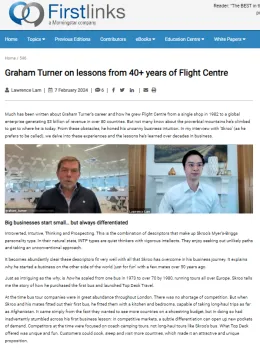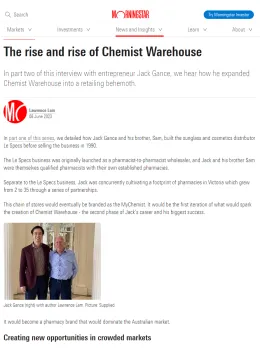This article was first published in Livewire Markets, 2 April 2020: https://www.livewiremarkets.com/wires/now-is-the-time-to-beat-the-fundies
———-
Plenty of commentary has already been written about the economic impact of COVID-19. Whilst these opinions make for interesting reading and dinner table debate, they distract investors from the main issue at hand. How can enterprising investors capitalise on the tangible advantage they have over large institutional investors right now? How should long-term investors allocate capital in this environment? What can you do now to prepare for the inevitable rebound?
Current Sentiments – am I catching a falling knife?
Some investors are cautious about the current environment. Is there worse to come? Am I catching a falling knife?
The fact is most stock prices have been falling. They are all falling knives. Catch the best knife and you’ll be rewarded when this uncertainty clears. Stock prices will be volatile over the coming months. It is highly likely we haven’t seen the worst. The question shouldn’t be ‘am I catching a falling knife?’, it should instead be ‘which is the sharpest knife to catch?’.
Structural constraints for some, inherent advantage for others
Large institutional investors have in-built risk triggers that have been set in motion by the market pullback. Rather than making rational decisions about the merits of the actual underlying investments they hold, hardcoded rules force large institutional investors to divest during this current pandemic. For example, the government’s $10,000 tax-free superannuation withdrawals has forced super funds to liquidate investments to maintain appropriate cash buffers for redemptions, even as their portfolios continue to be devalued. The pressure to divest is strong. Clients are redeeming and this places pressure on large funds to crystalise their losses and hold cash during this time. The selldown leads to more selling and an even sharper self-fulfilling pullback.
Companies I have been stalking for years have been written down significantly, some by more than one third. These remain sound companies with strong balance sheets and moats, yet their valuations are suggesting permanent irreparable damage to their businesses. This is simply irrational.
For enterprising investors without institutional constraints, this is a once-in-decade opportunity. Sure, there will be volatility ahead, but capital is being pulled with no sensible consideration to the actual underlying value of companies. Now is when you can exploit the structural constraints faced by large institutional fund managers.
Instead of the usual buy/sell stock recommendation, I’ll share a framework for how you can strategically position your portfolio during this period in preparation for when institutional investors come flooding back and you can get in ahead of the rebound. So here’s how you might do exactly that.
Read the play – cash allocation
Of course to fully capture the discounted pricing at the moment, investors should have enough capital to deploy for these opportunities that arise. I’ve written previously about gauging the investment climate and how to utilise trends to your advantage. Unlike large fund managers, you are not hamstrung by requirements to be fully invested. The absolute freedom to control the level of cash in your portfolio is a key advantage. To realise this, preparation should have been done to take stock of the prevailing market environment. The low interest rate environment in recent years has lulled investors into holding less cash and encouraged them to seek out more adventurous investment opportunities. Besides a buying opportunity in late 2018, enterprising investors who held higher than usual levels of cash are now being rewarded with the opportunity to invest in quality companies at very reasonable prices.
For Lumenary Investment Management, we came into 2020 with a quarter of our fund held as cash. Many thought we were being too conservative, but my view was the fundamentals justified such an approach. The dry powder is now coming in handy.
But for investors who have not been able to fully prepare coming into this correction, it is not too late. You can still maximise your chances in anticipation of the next phase, and the inevitable rebound.
The first question you need to ask
‘Will this company survive the economic hiatus?’. This is the first question investors must address. The answer? Look at the cash flow statement. Break it down into controllable and non-controllable items.
Which cash flows must be paid and which ones can management control?
What short and long term liabilities need to be supported?
How much cash will a dividend suspension save the company?
Are there any debt facilities available immediately to cushion cash flows?
Bank analysts will term this as consideration of a company’s liquidity position.
Never has the cash flow statement and balance sheet been so in fashion.
Assuming you’re comfortable with the prospects of survival, only then should investors draw their attention to the post-COVID-19 world.
A simple (maybe controversial?) systematic risk reduction strategy
The central component to how I systematically reduce risk is by focusing on founder-led companies.
Founders are very attached to their companies, they reap the economic and reputational reward (and risks) of a well-run company. This is exactly why we like investing in them. In extreme times, knowing that we are invested alongside a founder who has just as much to gain (if not more), gives us a strong foundation of confidence. We are also very fond of the governance structure that typically allows for long-term continuity and a focus on compound growth rather than individualised short-term bonus incentives. Sure, pundits will point to plenty of bad founders (we’re all thinking of Adam Neumann of WeWork here) and no doubt these exist, but that is why being a founder-led company should only be the start of the search. There are still plenty of other criteria that must be addressed before you should consider a company worthy of investment.
Look for income deferral, not permanent loss
One thing is certain – almost all companies will see a fall in revenues. This shouldn’t be a surprise to investors. Instead, look for companies that have a product or service that their customers will come flooding back to when business resumes. Just think about that car you’re set on buying. You’ll buy it. It’s simply a matter of when. Even if you can’t buy it now, you’ll wait until after the lockdown. Look for companies where income is deferred, not permanently lost.
We have recently invested in a biomedical company that is one of only five global suppliers to the world’s fertility market. Many clinics are shut for now, but the baby-making business and human desire to have children is most certainly only in hibernation. Expect it to resume booming once the lockdown is over.
To further maximise your chances of success, investors should be prepared for unknown unknowns.
Is the house in order, or are they living on borrowed time?
Look for companies with minimal debt. Better still, look for zero-debt companies like I do. Why? For starters you can be sure they cannot go bankrupt. But secondly, those with minimal or zero debt will be cushioned against impacts by the still unknown market effects yet to play out.
We have yet to see the flow-on effects of the extreme government stimulus packages seen globally. How these packages are funded is not yet clear, but expect the credit quality of many governments to be put under pressure. This may have further impacts on broader credit markets and corporate debt. For this reason, maintain a level of appropriate caution.
We have recently entered into a position holding one of Europe’s largest live entertainment organisers. Acquiring their dominant market position and multi-channel distribution network at a 40% discount to the price at the start of this year is a no-brainer to us. And yes, it’s founder-led, has expected permanent income and zero debt.
Closing remarks
Catch the falling knife and catch the best one.
Institutions are under pressure to divest. The advantage now sits squarely with enterprising investors who are able to prepare for the stock market’s next phase.
Read the medical predictions if you want to contribute to the dinner table debate, but know it won’t help a great deal when it comes to making investment decisions. Instead, the cash flow statement and balance sheet is where you will find the clues you need.
If you’re sure the company can survive, then check the income is deferred, not lost, and be prepared for further volatility and uncertainty.
The opportunity to acquire quality companies at reasonable prices doesn’t come very often – allocate your capital wisely and you’ll profit when the lagging institutional investors follow you back into the market.
Happy compounding.
About me
Lawrence Lam is the Managing Director & Founder of Lumenary, a fund that uncovers the best founder-led companies in the world. We invest in unique, overlooked companies in markets and industries beyond most managers’ reach. We are a different type of global fund – for more articles and information about us, visit www.lumenaryinvest.com

Lawrence Lam
Managing Director & Founder




